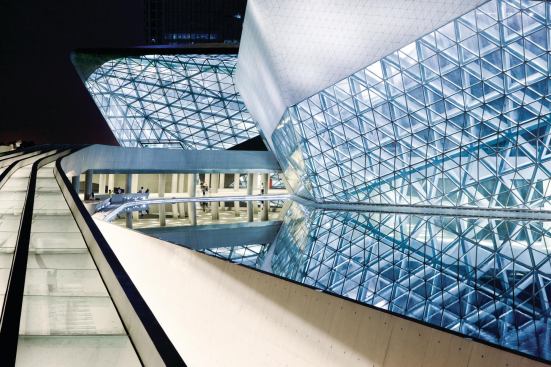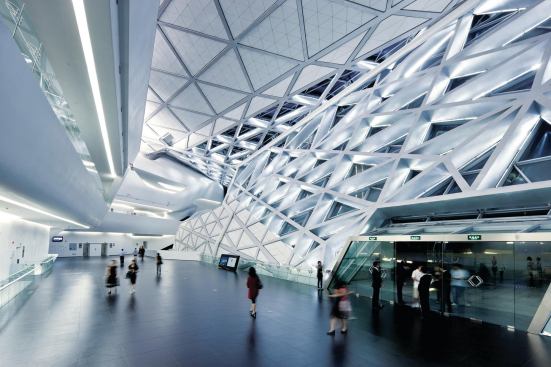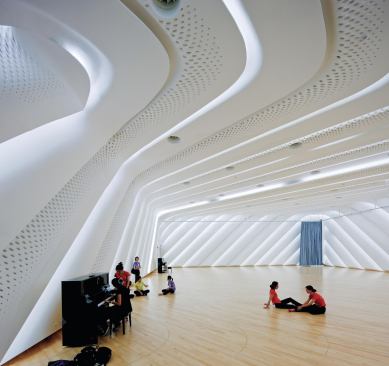Iwan Baan
Guangzhou Opera House
Zaha Hadid, Hon. FAIA, follows up 2009’s National Museum of the XXIst Century Arts in Rome (aka the MAXXI) with the largest and most complex example of her new generation of primarily computer-generated designs: the Guangzhou Opera House.
Hadid won the international competition for the project in 2002 by appealing to the inner poets of Chinese officials. Paraphrasing her analogy, two faceted buildings—the 1,804-seat opera and a 443-seat multipurpose theater—are smoothed by a proverbial stream that erodes the surrounding plazas into an urban landscape of valleys, ridges, and pools.
TOOLBOX: Structure
Building the poetic idea of structures as waterworn rocks required advanced computational technologies. “As usual,” Schumacher says, “we used several different programs. We worked the outer crystalline form in Rhino and the inner, more complex and fluid surfaces inside the auditorium in Maya.” Hadid, Schumacher, and Yao achieve organic forms through logarithms, through splines, blobs, NURBs, and particles organized by scripts of the dynamic systems of parametric design.
“The opera house structure,” Schumacher explains, “is a volume within a volume.” Housing the auditorium and fly tower is a concrete box with terraces cantilevering into the auditorium and lobby. The giant steel lattice that forms the exterior structure vaults out in all directions from this inner concrete volume, forming a shell with flat facets triangulated with steel members. The facets meet in rounded fillet edges that pivot each facet toward the next; the facets themselves converge in sprockets projecting from what Schumacher terms a “knot.” These huge star-shaped joints—59 of which are used in the façade—are made of cast steel and were formed using an unexpectedly traditional technique: The joints were built out of wood that was then embedded in sand to form the molds into which the steel for the final nodes was poured. These joints support the facets of the steel lattice, and the whole armature—knots, fillets, and lattice together—acts as a rigid surface.
The architects covered both structures in triangular tiles of rough granite—one black, the other white. “The tesselation on the flat surfaces is trivial,” Schumacher says, “but covering the fillets is more complicated, requiring curved pieces of granite stitched together in tesselated patterns, like a football. The structural mesh was indifferent, so it could receive granite or glass. We used glass in fields that allow you to see the structure and the inside of the lobbies.”
The geometry of the auditorium represents a different mathematical species altogether, developed in Maya as NURB surfaces (doubly curved surfaces morphing between convexity and concavity). Working in Maya, the architects sent digital files to the factory where the data was translated and milled into molds into which the final material—glass fiber–reinforced gypsum—could be cast. The forms were put together on site, forming continuous, seamless surfaces.
“The two buildings are embedded in an artificial landscape impregnated with program and spaces,” explains Patrik Schumacher, who—along with fellow project director Woody K.T. Yao—designed the project with Hadid.
Hadid’s buildings have sometimes been accused of standing aloof, but in fact she conceives her structures urbanistically: The scope of her brief and this large transitional parcel between the city’s financial district and the Pearl River allowed her to build at a scale that addresses her theory that a building need not be distinct and separate from the surrounding city, that the two can structure and activate one another. At Guangzhou, the buildings and cityscape connect via pedestrian and vehicular ramps and a complex multilevel topography.
The buildings were not conceived planimetrically, with notions of front, back, and sides, but rather were modeled dynamically in 3D, so the resulting buildings and landscape are omnidirectional. Visitors approach the site and buildings from several directions and on several levels by vehicular and pedestrian roads ramping through long pools of water. The rising and lowering ground planes contain restaurants, offices, stores, and meeting rooms.
Outside, the buildings are defined by their faceted structural skin, covered in triangular tiles made of glass and white and black granite. The skin combines parametric geometry with traditional methods, such as the sand-casting of the main structural steel nodes, and it is vaulted off of a separate, interior volume of concrete that houses the opera theater.
The lobbies are voluminous, column-free public rooms. Terraces and staircases cantilevering from the theater volume provide a grand architectural promenade and a stage for the audience itself. The lobbies wrap most of the hall so that audiences can circumambulate the theater.
The sweeping staircases and sculpted terraces of the foyer in the main volume give way to the auditorium, where curving balconies—designed to fragment the sound acoustically and to assure sight lines—emerge smoothly from walls, forming continuous surfaces within what Schumacher calls the “balanced asymmetry” of the auditorium. Here, Hadid refines the vineyard terracing first used by Hans Scharoun in the visually lyrical Berlin Philharmonie in 1963. Overhead, an installation of 4,000 LED fixtures dots the ceiling.
Behind the proscenium stage, the support functions are housed in an orthogonal matrix of rooms that do not conform to the confines of a neat, regular euclidean package. Instead, the irregular shell outside adapts to the programmatic and volumetric needs of the back-of-stage functions inside: The boulderlike forms of both buildings are not simply the result of picturesque massing, but an expression of interior function.
The design of the complex expands the scope of the two buildings to the edges of the site. Visitors entering their orbit immediately become subject to an orchestration of curves melding into counter curves, within a precinct of wonder that conditions them for the performances inside.
One little-noted role of an opera house is to prepare visitors to suspend disbelief by establishing a transitional experience between the real world outside and imaginary world within. In fulfilling this traditional role, Hadid’s opera house keeps good company: hers arguably ranks with Garnier’s in Paris, and Utzon’s in Sydney as a defining moment in the evolution of the building type.
The Guangzhou Opera officially opened this February, but in Hadid’s operatic environment, the overture really started at the edges of the site, where Hadid hit, on pitch, a very high C, long before the audience heard the first note.
Project Credits
Project Guangzhou Opera House, Guangzhou, China
Client Guangzhou Municipal Government
Architect Zaha Hadid Architects, London—Zaha Hadid, Hon. FAIA (design); Patrik Schumacher, Woody K.T. Yao (project directors); Simon Yu (project leader); Christine Chow, Jason Guo, Ta-Kang Hsu, Filippo Innocenti, Junkai Jiang, Long Jiang, Yang Jingwen, Hinki Kwong, Yi-Ching Liu, Lourdes Sanchez, Cyril Shing, Zhi Wang (project team); Christina Beaumont, Yael Brosilovski, Paola Cattarin, Hon Kong Chee, Achim Gergen, Lorenzo Grifantini, Viggo Haremst, Martin Henn, Jenny Huang, Filippo Innocenti, Tamar Jacobs, Flavio La Gioia, Christian Ludwig, Imran Mahmood, Graham Modlen, Matias Musacchio, Markus Planteu, Nina Safainia, Fernando Vera (competition team First stage); Adriano De Gioannis, Yosuke Hayano, YanSong Ma, Barbara Pfenningstorff, Cyril Shing (Second stage)
Local Design Institute Guangzhou Pearl River Foreign Investment Architectural Designing Institute
Structural Engineers Shanghai Tongking Science and Technology Development Co.; Guangzhou Pearl River Foreign Investment Architectural Designing Institute
Façade Engineering King Glass Engineering
Building Services Guangzhou Pearl River Foreign Investment, Architectural Designing Institute
Acoustic Consultants Marshall Day Acoustics
Theater Consultant China ENFI Engineering Group
Lighting Design Consultant Beijing & Light Co.
Project Management Guangzhou Municipal Construction Group Co.
Construction Management Guangzhou Construction Engineering Supervision Co.
Cost Consultant Guangzhou Jiancheng Engineering Costing Consultant Office
Principal Contractor China Construction Third Engineering Bureau Co.
Size 753,474 square feet (project); 456,314 square feet (site)
Cost ¥1.38 billion ($211.4 million)
Materials and Sources
Solid Surface LG Hausys (Hi-Macs) himacs.eu
Flooring Nora Systems nora.com
Fabrics and Finishes Kvadrat (seating fabric) kvadrat.dk
Seating Shenge Industrial (auditorium seating) chinashenge.com
Wall Systems E-Grow (Shanghai) International Trading Co. (auditorium wall panels) egrow3dsolutions.com





















